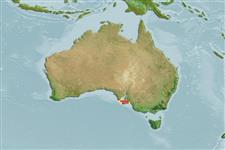Common names from other countries
Elasmobranquios (tiburones y rayas) (sharks and rays) >
Rajiformes (Skates and rays) >
Rajidae (Skates)
Etymology: flindersi: Named for Flindersian Province, name for this skate’s distributional range (the western warm temperate biogeographic region of Australia).
known as the.
More on authors: Last & Gledhill.
Environment: milieu / climate zone / depth range / distribution range
Ecología
marino bentopelágico; rango de profundidad 27 - 54 m (Ref. 75646). Subtropical; 34°S - 38°S, 135°E - 139°E (Ref. 114953)
Eastern Indian Ocean: restricted distribution off southern Australia.
Tamaño / Peso / Age
Maturity: Lm ? range ? - ? cm
Max length : 31.6 cm TL macho / no sexado; (Ref. 75646); 32.6 cm TL (female)
Inhabits inner continental shelf (Ref. 114953). Males observed to be adolescent at 25.1 cm TL, mature at 28.9-31.6 cm TL, with smallest juvenile at 17.4 cm TL (Ref. 75646).
Life cycle and mating behavior
Maturities | Reproducción | Spawnings | Egg(s) | Fecundities | Larva
Last, P.R. and D.C. Gledhill, 2008. A new skate of the genus Dentiraja (Rajoidei: Rajidae) from southern Australia. pp. 9-52. In Last, P.R., W.T. White, J.J. Pogonoski and D.C. Gledhill (eds.): Descriptions of new Australian skates (Batoidea: Rajoidei) pg. 109-118. CSIRO marine and atmospheric research paper no. 021. (Ref. 75646)
IUCN Red List Status (Ref. 130435)
CITES (Ref. 128078)
Not Evaluated
Threat to humans
Harmless
Human uses
Herramientas
Special reports
Download XML
Fuentes de Internet
Estimates based on models
Phylogenetic diversity index (Ref.
82804): PD
50 = 0.5010 [Uniqueness, from 0.5 = low to 2.0 = high].
Bayesian length-weight: a=0.00302 (0.00141 - 0.00645), b=3.24 (3.07 - 3.41), in cm Total Length, based on LWR estimates for this (Sub)family-body shape (Ref.
93245).
Nivel trófico (Ref.
69278): 3.9 ±0.6 se; based on size and trophs of closest relatives
Resiliencia (Ref.
120179): Bajo, población duplicada en un tiempo mínimo de 4.5-14 años (Preliminary low fecundity).
Fishing Vulnerability (Ref.
59153): Low vulnerability (23 of 100).
